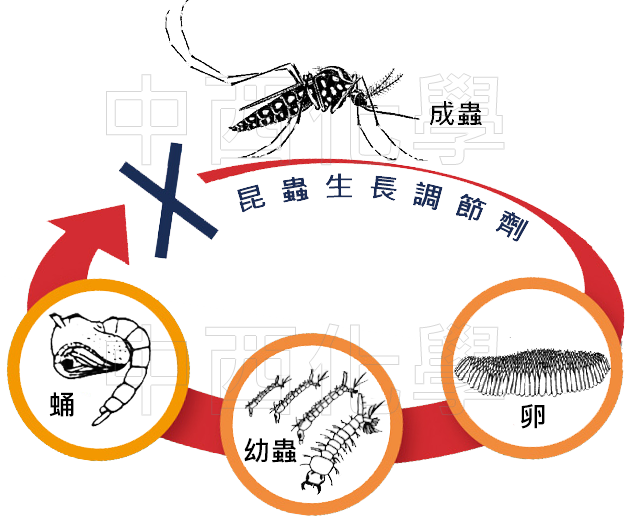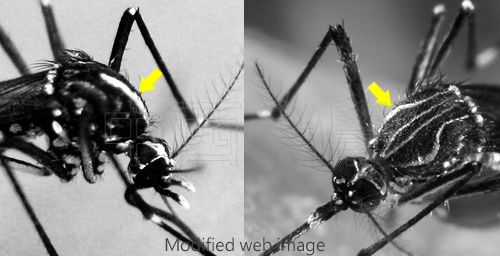BACK
2023 / 12 / 25

The main impact of mosquitoes on people is the itching caused by bites. People who are allergic to mosquito saliva may even experience severe symptoms of redness, swelling or blisters. Mosquitoes disturb people's sleep at night and are also annoying characteristics of domestic mosquitoes.
There are also some similar insects that are often confused with mosquitoes, but in fact they do not suck blood or transmit diseases, such as chironomid midges (the larvae are "red worms") and the crane flies. As long as a common biting midge species Forcipomyia taiwana is called “small black mosquitoe” in Chinese in Taiwan because of their ability of sucking blood. Though it has "mosquito" in Chinese common name, they belong to Family Ceratopogonidae of the Order Diptera in fact.
In addition to the problems of harassment and bites caused by mosquitoes, many diseases are transmitted through vector mosquitoes, which is the biggest threat to people's lives. Diseases transmitted by mosquitoes include:
‧ Aedes aegypti, A. albopictus: Dengue fever, dengue hemorrhagic fever, Chikungunya, Zika virus infection, yellow fever, etc. (Zika and yellow fever are related to A. aegypti)
‧ Culex tritaeniorhynchus summorosus, C. annulus, C. fuscocephala: Japanese encephalitis, Rift Valley fever
‧ Anopheles sinensis, Anopheles minimus: Malaria
‧ C. quinquefasciatus, C. pipiens: Filariasis, etc.
‧ Culex tritaeniorhynchus summorosus, C. annulus, C. fuscocephala: Japanese encephalitis, Rift Valley fever
‧ Anopheles sinensis, Anopheles minimus: Malaria
‧ C. quinquefasciatus, C. pipiens: Filariasis, etc.
Generally common harmful species are mosquitoes from genus Aedes, Anopheles and Culex. Anopheles mosquitoes that can transmit malaria only distribute partially in Taiwan at extremely few locations in the wild. Aedes (Stegomyia) aegypti and Aedes albopictus are very common in Taiwan. Among them A. aegypti mainly distribute in southern part of Taiwan and Penghu island, but A. albopictus are nation-wide distribution. Between 2015 and 2016, more than 200 Taiwanese died because of dengue/dengue hemorrhagic fever, which was the most serious insect vector disease event in recent years. The two can be distinguished by the appearances on their adults' chest. In addition, A. aegypti breeding sources are both indoors and outdoors, while A. albopictus is mainly found outdoors. A. aegypti are easily disturbed while sucking blood, and they often bite multiple times to obtain enough blood, that's why A. aegypti is more important in the mass vector control program. Culex spp. are quite common in urban area and nuisance at night. Another common mosquito species Armigeres subalbatus also distributes widely in Taiwan due to polluted water, it is relatively big mosquito with more painful bites, however it doesn't transmit disease.

Aedes albopictus (left) and Aedes aegypti (right)
Mosquito management
Eliminating disease-vectoring mosquitoes cannot only focus on adult mosquitoes that can bite people. Killing or driving away adult mosquitoes is a temporary solution, while rectifying the environment and preventing and controlling larvae is a fundamental solution. Eggs, larvae, and pupae will not run around. If the breeding source can be controlled, the trouble caused by adult insects can be greatly reduced.
There are many ways to prevent and control adult mosquitoes:
‧ Use aerosol spray and smoke bomb insecticides to kill adult mosquitoes.
‧ Use mosquito coils and electric mosquito vapor liquid to repel or kill adult mosquitoes.
‧ Use ovi-traps and mosquito traps to capture them (it is best not to have people around when using mosquito traps).
‧ Use mosquito repellent on clothing or exposed skin to repel approaching adult mosquitoes.
‧ Place mosquito repelling sheets on doors, windows and other potential entry points to repel adult mosquitoes.
‧ Install mosquito nets, screen windows, and screen doors. Remember to repair any damage.
‧ Install a cover or net that can be closed manually or automatically at the outlet of the drainage pipe to prevent pipeline intrusion.
‧ Electric mosquito swatters are also a good mosquito killing tool.
Preventing and controlling mosquito larvae: First, we must understand the possible breeding sites of various mosquito larvae
‧ Aedes aegypti and Aedes albopictus: water stagnant containers, waste tires, basements, vases, tree holes, bamboo tubes and other water stagnant locations.
‧ Culex tritaeniorhynchus summorosus, C. annulus, C. fuscocephala: suburban waters such as paddy fields and ponds.
‧ Anopheles sinensis, Anopheles minimus: clean waters in wild environments.
‧ Culex quinquefasciatus, C. pipiens: dirty and turbid water accumulation locations such as gutters, ditches, and sewage pools.
‧ Armigeres subalbatus: old toilets, septic tanks, etc.
In addition to cleaning, dredging, draining and other methods to rectify breeding water sources, you can also apply insect growth regulator (IGR) such as SumiLarv® 0.5G produced by Sumitomo Chemical of Japan, which contains active ingredient pyriproxyfen. The structure of pyriproxyfen is similar to the juvenile hormone (JH) in the body of larvae that controls molting. It can interfere with the development of insect larvae after application, causing them to eventually fail to emerge and die. Because JH is a hormone unique to insects, the use of SumiLarv® 0.5G will not affect fish, amphibians, reptiles, birds and mammals; through its sustained-release formula, it can be maintained at low doses for several months. For a long time, it has been widely used by the World Health Organization in some countries for mosquito vector control programs.
Preventing and controlling vector-borne mosquitoes is a task that everyone should do together, and it is even more important to clean up or spray pesticides on breeding sources near our homes.

